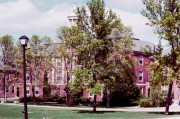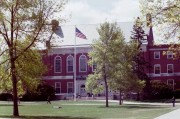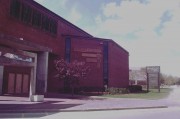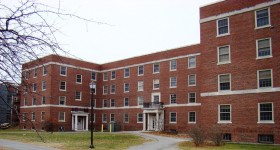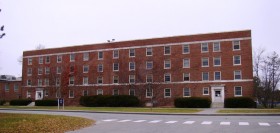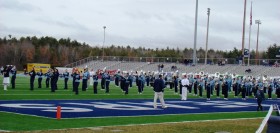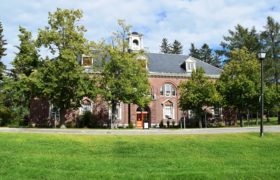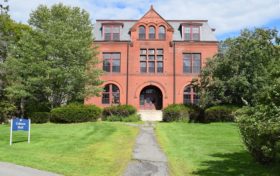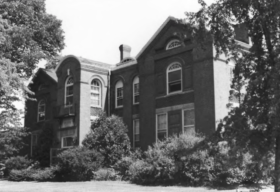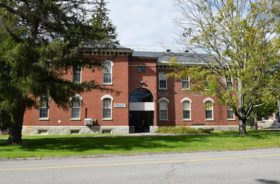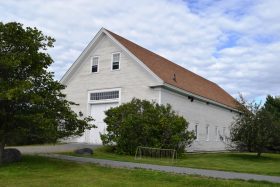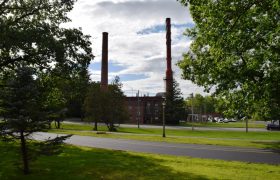The 1873 President’s House is an elegant, restored, Victorian-era structure. Historic photographs show the early care given to the house’s landscaping, including newly planted trees. The mature trees on the house’s front lawn comprise native species, such as American beech as well as non-native species. This mix of indigenous and introduced species is true of the campus as a whole.* More historic university buildings.
The University was founded in 1865 as one of many land grant institutions, a direct outcome of the Morrill Act approved by President Lincoln, July 2, 1862. The legislature accepted the conditions of the Act in 1863 and in 1865 created a corporation to administer the affairs of the College, which opened in September, 1868 with twelve students and two faculty members.
By 1872 women were admitted to all areas of the curriculum. The original name was “The State College of Agriculture and the Mechanical Arts.” In 1897 the legislature changed the name to “The University of Maine.” The School of Education was established in 1930.
For many years its Orono location was the only campus, then it became the “jewel in the crown” of the “Super University System,” which integrated campuses around the state under a single chancellor, but each with its local president.
In 1986 The Maine Center for the Arts opened on the Orono Campus. It was renovated, expanded, and renamed the Collins Center for the Arts in 2007. The Center is home to the Bangor Symphony Orchestra, the Hudson Museum, is a performance space for visiting artists, and serves as a lecture/conference venue.
Since the 1970’s, the Orono campus has lost has lost status and financial resources to the University of Southern Maine, a fast growing urban campus in the Portland area. (See colleges for enrollment details.)
The University of Maine System is the overall administrative structure for Maine’s public universities. A Chancellor is the chief executive officer of the multi-campus system, and the Board of Trustees is its governing body. The Board members are appointed by the Governor, with the approval of the Legislature. The Board selects the Chancellor.
The system campuses are the University of Maine (located in Orono), the University of Southern Maine (in Portland and Gorham), and five others known as the University of Maine at Augusta, Farmington, Fort Kent, Machias, and Presque Isle respectively.
Graduates of the University who became U.S. Representatives include Clifford G. McIntire.
National Register of Historic Places – Listings
Photos, and edited text are from nominations to the National Register of Historic Places researched by Maine. Historic Preservation Commission.
Full text and photos are at https://npgallery.nps.gov/nrhp
University of Maine at Orono Historic District
[Munson, Sebec, and Schoodic Roads]
The buildings in the District represent the earliest structures remaining on this first and principal campus of the state university. Founded as a result of the Morrill Land Grant Act of 1862, the Maine State College of Agriculture and Mechanic Arts opened its doors to students for the first time on September 21, 1868. At that time there were only two professors and twelve students. Life at the young college was quite different from today. The accommodations for students were extremely primitive and sanitary requirements were satisfied by a giant unheated privy on the slope behind Fernald Hall. The Town of Orono was in its heyday, boasting the largest sawmills on the Penobscot. Logs jammed the Stillwater River as booms and a canal channeled them into the Basin Mills at Orono.
But on Marsh Island where the little college began, life was largely removed from this activity. There was no public transportation between the town and the college until the electric trolley came during the 1880s. Since most of the students taught school periodically for self-support, the academic year was set up around their schedules. The fall semester, for example, ran from August through Thanksgiving followed by an eleven week vacation and the spring semester concluded around July 4th with a month off for haying season. The modern college year was not instituted until 1898, the year after the State Legislature officially renamed their “cow college” the University of Maine.
The original plan of the campus was drawn by the preeminent landscape architect Frederick Law Olmstead, who also drew up a proposed curriculum and statement of educational philosophy for the College. The earliest building within the district, Fernald Hall, was built with student labor between 1868 and 1870. Manual labor was a part of the educational program, classes being held in the mornings and work on the farms and buildings being done in the afternoons. Holmes Hall, built in sections between 1888 and 1913 and Coburn Hall, 1887- 1888 were both designed by Frank E. Kidder, Boston architect and 1879 alumnus of the College.* [Frank A. Beard B&W photos]
University of Maine Historic District Boundary Increase
Date listed: 4/27/2010
Architecture, Education, Landscape Architecture, Agriculture, Community Planning and Development. Statewide significance.
In 1978, the University of Maine at Orono Historic District was listed in the National Register. That district focused on the oldest of the university buildings (1868 – 1909) and was located in the western section of the 600 acre campus. The goal of the Historic District Boundary Increase was to provide additional descriptive information on those already listed properties, add information about their site, location, and landscape, and to then expand the boundaries of the district to encompass the adjacent resources and landscapes built between 1891 and 1942.
The University of Maine was founded as the Maine State College of Agriculture and Mechanic Arts in 1865, with Federal funding from the Morrill Act of 1862, which provided land to states to finance higher education in agriculture and engineering, thus creating “land grant” colleges and universities. Over the years, the Campus grew in roughly three phases. The initial phase began with the formation of the college in 1865 and extended to the mid-1910s. During that period the campus consisted of academic buildings facing the Stillwater River and agricultural buildings for the college farm located to the east. In 1866 the College’s trustees hired the renowned landscape architect Frederick Law Olmsted to design a plan for the campus that used the river as its focal point.
The Experiment Station remained an independent agency until 1887 when Congress enacted the Hatch Act, establishing similar institutions in every state. The Maine Legislature repealed the Act of 1885 and made the Station a separate department of the College. A decade later the entire College farm was placed under the management of the experiment station. By then, the buildings associated with the station included Holmes Hall (built for the station in 1888), a horticultural building, a dairy building, the two barns, and a host of other smaller structures such as a hospital barn and a poultry breeding house. Feeding experiments were undertaken in the barn that had been newly built by the College. Stalls were provided for seventeen cows and a number of horses, the latter of which were for “…such station officers as live at a distance from the College buildings.”
There were 80 acres under cultivation and 40 in pastures and paddocks. With the construction of Merrill Hall on this site, the barn was moved about 1930 to its present location, a few hundred feet to the east of its original site. At this time the building was relegated to use as a “tool shed,” and storage function.* See related: Page Farm and Home Museum
The Barn has been restored and re-purposed as a museum. Its mission is to collect, document, preserve, interpret and disseminate knowledge of Maine history relating to farms and farming communities between 1865 and 1940, providing an educational and cultural experience for the public and a resource for researchers of this period. The Museum contributes to the educational mission of the University. The Maine Experiment Station barn, a post and beam structure, is the centerpiece of the Museum.
Although they never fully executed Olmsted’s design, the Trustees adopted many of his ideas in the early years of campus planning. During the second phase of campus development, from the early 1920s to the end of World War II, the central Campus Mall and the South Mall became the locus for new construction.
The University hired the Olmsted Brothers, Frederick Law Olmsted’s successor firm, to provide a campus plan in 1932, which, although it was also not fully implemented, provided the plan by which the campus has today developed it spatial identity. The third, post World War II, phase of campus development is beyond the scope of the current district expansion. The expanded University of Maine Historic District is significant in the areas of architecture, education, landscape architecture, agriculture and community planning and development. The expanded district now contains 27 contributing buildings, four contributing sites, and six non-contributing buildings.
Phi Gamma Delta House, 1925
Phi Gamma Delta House
The Phi Gamma Delta House is important both for its architecture, and for its association with the educational programs of the University of Maine. In the early 20th century, the University of Maine’s population grew more quickly than its capacity to house its students. Built in 1925, the Phi Gamma Delta House, along with other chapter houses on campus, provided living space for its fraternity brothers, thereby assisting the University of Maine in its mission to provide a college education in Orono. It is significant for its architecture as a good example of the Tudor style in an educational setting and it is the only Tudor-style fraternity house on the University of Maine campus. With its intact dormitories, study rooms, public spaces, kitchen and meeting hall, Phi Gamma Delta fraternity house is also a good example of a specific building type. The house has seen very few exterior or interior renovations since construction was complete on the building in 1925, and continues to serve as the chapter house for the fraternity.
Additional resources
Photos, and edited text are from nominations to the National Register of Historic Places researched by Maine. Historic Preservation Commission.
Full text and photos are at https://npgallery.nps.gov/nrhp
*Text from “Trees at President’s House.” https://umaine.edu/sights/garden-tour/trees-presidents-house/ (accessed September 5, 2019)
University of Maine, Raymond H. Fogler Library, Special Collections
Bailey, Judith I. A Framework for Change: Teaching, Research, and Outreach. Orono, Me. University of Maine, Division of Academic Affairs. 1996.
Chamberlain, George Walter. “The University of Maine.” Extract from: Americana. January, 1910.
Fernald, Merritt Caldwell. History of the Maine State College and the University of Maine. Orono. University of Maine. 1916.
Hauck, Arthur Andrew. Maine’s University and the Land-grant Tradition. New York. Newcomen Society in North America. 1954.
The University of Maine Historic Preservation Master Plan: March 2007. Orono, Me. University of Maine. 2007. [University of Maine, Raymond H. Fogler Library, Special Collections]



